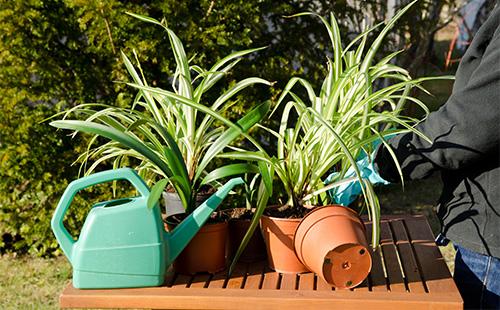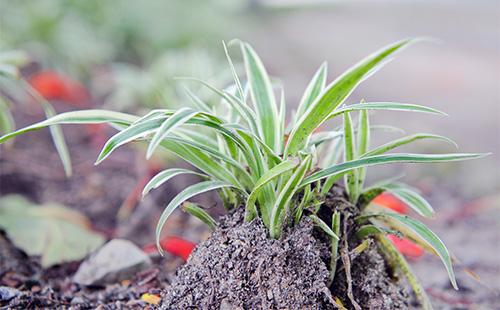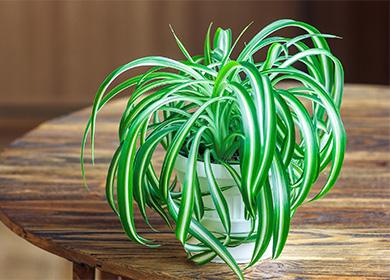The content of the article
Interest in chlorophytum significantly decreased after the appearance of new exotic cultures on store shelves. Connoisseurs should pay attention to the new hybrid varieties with improved decorative characteristics.
Plant description
Chlorophytum is a perennial herb. Its height usually does not exceed half a meter. The stem is not visible, thin leaves form a basal rosette. The root system is developed, strong. Tuberoid thickenings contain moisture reserves.
Leaves linear, sessile or on short petioles. The color is plain or with light stripes. The length of the leaves, depending on the variety, varies from 15 to 60 cm. On the back side, the swollen main vein is distinctly distinguished.
Chlorophytum releases a long mustache. In the summer, flowers form on them. They bloom in groups or fold into a small cob-shaped inflorescence. When flowering ends, children form on the mustache - daughter rosettes with roots. After pollination, a seed box of three nests matures.
Popular Indoor Views
In the genus of chlorophytums, there are about 200 different plants. In floriculture, only a few species are used. But on their basis, breeders have developed additional varieties with interesting colors. Of the most interest are five varieties.
- Chlorophytum crested. The leaves are linear, very long, narrow. They form a symmetrical, thick basal rosette, with a diameter of up to half a meter. A mustache grows from the outlet, which are long bare shoots. They form flowers and small daughter sockets. An adult, freely growing bush resembles a voluminous green fountain.
- Chlorophytum curly. It has more compact dimensions. Thin narrow leaves are wrapped in a fancy spiral. In the central part of the leaf stands out a wide bright strip.
- Chlorophytum Cape. The leaves are light, narrow lanceolate. With good care, they grow more than half a meter in length. Leaf sockets are tight. Small white-cream flowers are kept on short peduncles. He doesn’t let out whiskers, he doesn’t form children;
- Chlorophytum winged. Compact plant a little less than half a meter tall. The leaves are oval, wider than other varieties. Petioles are small, fleshy, orange.
- Chlorophytum Laxum. A rare species with thin leaves. On both sides of the sheet are distinct white stripes. The socket is tight, babies do not form.
How to properly care for chlorophytum after purchase, so that it adapts faster and grows? For two weeks it is kept in quarantine, watered sparingly, do not feed, do not spray, do not put in the sun.
Care for chlorophytum in different periods of growth
Chlorophytum is unpretentious and easy to grow. How to care for chlorophytum in order to maintain its decorativeness and avoid most problems, we will consider below.
- Lighting. Choose a bright or slightly shaded place. Direct sun or full shadow negatively affects the appearance of the leaves. Variegated varieties are more demanding on the level of lighting. With a lack of light, the leaves lose their characteristic mottled color.
- Temperature. In the summer, adapts to any temperature, easily tolerates heat. In warm weather, it is useful to bring chlorophytum to the balcony or courtyard, providing protection from wind and precipitation. In winter, like most indoor crops, chlorophytum is desirable to provide coolness. Cooling below 10 ° C is not allowed.
- Watering. During the growing season, the plant consumes a lot of moisture, so water it abundantly, often enough. In winter, watering is limited, but make sure that the soil always remains slightly moist. Water should not stagnate in the root system. If you properly water chlorophytum, you can avoid the common problem of rotting the roots.
- Humidity. Chlorophytum tolerates dry air, but spraying is good for it. If the humidity is low, the ends of the leaves dry out, the appearance of the plant becomes slightly untidy. In winter, spray only with a warm content.
- Top dressing. Organic and mineral fertilizers are alternated every two weeks. Chlorophytum begins to feed in the spring. They continue to fertilize throughout the growing season. In winter, the need for nutrients is reduced.
- The soil. Use soil with neutral acidity. The main requirements for the quality of the soil mixture are lightness, friability, air permeability. The composition includes sod, humus, deciduous land and sand.
- Transfer. The optimal time for transplantation is the end of winter or early spring, even before the start of active growth. Young specimens require an annual transplant, adults can not be disturbed for two to three years. Carefully inspect the root system - its condition may indicate errors of care. A large number of large nodules on the roots indicates irregular watering.
Features of the care of chlorophytum after transplantation - moderate watering, content in partial shade. Fertilizing for a month is suspended, regularly sprayed. If a bush was divided during the transplant, a small amount of root stimulant is added to the water for irrigation. The most common drugs are Heteroauxin, Kornevin.
Breeding methods
You can propagate chlorophytum by dividing the bush, children and seeds. The latter method is rarely used - it is laborious and time consuming. But seed propagation may well be used to grow new varieties. In other cases, it is better to use the vegetative method.
Child sockets
Most varieties of chlorophytum form daughter rosettes on a long, bare mustache. They are already viable plants that, when released into a good environment, quickly take root. For reproduction, mature sockets with roots are chosen.
To build up the roots, the baby is immersed with a base in a container of water with the addition of a root stimulant, left for several days. Then they are planted in light soil, covered with a jar or polyethylene until stable signs of growth appear. The main advantage of this method is the reproduction by children all year round.
Dividing the bush
Divide adult bushes at the age of three years. The method is used mainly for varieties that do not let out whiskers with children. Divide the bush in the spring, at the same time as another transplant.
Chlorophytum is preliminarily watered and left for a couple of hours so that the soil is completely saturated. The plant is extracted from the pot, which does not destroy the earth. With a sharp sterile knife, cut the bush into the desired number of parts. Dry, softened roots are cut off, all sections are treated with coal powder and fungicide.
Delenki planted in separate small pots filled with loose soil with the addition of sand. For several days they are covered with plastic bags with small holes so that rooting proceeds faster.
Seeds
New hybrid varieties can be grown from seeds. Seeds are better to buy in specialized stores. The germination rate even with fresh planting material is 25–40%, so it is better to sow with a margin.
Before sowing, the seeds are wrapped in a tissue, soaked in water with the addition of a few drops of a growth stimulator. Every four to six hours, the water is changed. The container is filled with a substrate consisting of peat and perlite.
Uniformly spread the seeds, lightly crush them, spray the soil with water. The container is covered with a film on top, placed in a warm, shaded place. Until the moment of seed germination, a stable temperature is maintained at the level of 22–25 ˚С. The container is regularly ventilated, if necessary, slightly moisten the soil from the spray.
Seeds germinate for a long time - at least a month will pass before the emergence of seedlings. After the formation of the first real leaf, the shelter is removed, after the second and third, seedlings are dived into separate containers.

Common florist errors
Incorrect watering, inappropriate place, too dry air - these and some other factors reduce the decorativeness of chlorophytum. To correct care errors and prevent them from happening again, review the table.
Table - Common Chlorophytum Care Mistakes
| Outward manifestation | Source of problem | Help the plant |
|---|---|---|
| Chlorophytum dries up | - Weak watering; - small volume of the pot; - pest damage | - Transplanted into a larger pot; - regularly watered; - inspect for pests, if necessary, treated with an insecticide |
| Chlorophytum does not bloom | - Not enough age for flowering; - big pot | - Comply with the recommended care regimen |
| The tips of the leaves are dry | - low humidity | - Regularly sprayed; - increase humidity by any means |
| Leaves lose elasticity | - cold; - excess nutrients | - Feeding pause; - chlorophytum rearrange to heat |
| Chlorophytum turns yellow | - heat; - poor lighting; - stagnation of moisture in the root area | - Rearrange to a cooler place; - check the roots and regulate the irrigation mode; - establish additional illumination |
| Leaves lose their mottled color | - Lack of light | - Rearrange closer to the window or install additional backlight |
| Blacken leaves | - The combination of cold and excess water; - heavy clay soil | - Chlorophytum is transplanted with the removal of damaged leaves and roots; - moderately watered until the plants recover |
| The tips of the leaves turn brown | - Lack of trace elements; - dry air; - heat; - sunburn | - Eliminate all possible causes |
| Leaves wrinkle, edges turn brown | - lack of moisture | - Regularly watered and sprayed |

Diseases and pests of the flower
Chlorophytum is susceptible to only two diseases - sulfur and root rot. In both cases, the disease causes fungus. Its development provokes poor drainage, excessive watering. Especially often rot has to be encountered during the dormant period if conditions of detention are not respected.
Treatment begins immediately - the slightest delay leads to the death of the plant. Chlorophytum is taken out of the pot, all affected roots and leaves are cut, treated with fungicide, coal powder, planted in fresh sterile soil. At first they water it gently - slightly moisten the soil. Additionally, several children are rooted in case of death of the plant.
You have to deal with pests much more often. For chlorophytum, most pests of indoor flowers are dangerous. The table indicates on what grounds to identify insects, how to deal with them.
Table - Chlorophytum Pests
| Insect name | How does it manifest | What to do |
|---|---|---|
| Thrips | - Silvery stripes appear on the leaves, which eventually cover the entire sheet; - small black dots (excrement) form on the plant | - Chlorophytum is washed in the shower; - sprayed with Actellik, cover the plant with a plastic bag and leave for a day |
| Spider mite | - The leaves turn yellow, dry; - with a strong defeat, a web appears | - They bathe the plant under a warm shower; - keep for several days under a plastic bag with daily airing; - sprayed with the drug "Actara" |
| Aphid | - The leaves become faded, deformed; - there is a plentiful sugar coating | - Chlorophytum is wiped with a soapy sponge, excess soap is washed off with water; - sprayed with any means based on permethrin |
| Shield | - Sticky drops appear on the leaves; - insects are detected, visible to the naked eye, which look like small, hard brown plaques | - Mechanically clean leaves from pests; - sprayed with diluted alcohol or vodka; - treated with any insecticide |
| Nematodes | - Slows down growth; - leaves are curled; - roots are damaged | - The plant is taken out of the pot, freed from the ground; - the roots are washed in warm, almost hot water; - treated with an insecticide, planted in a new pot |
| Mealybug | - There is a white waxy coating resembling cotton wool | - A soft soapy brush cleans the plant of pests; - sprayed with the drug "Biotlin" or "Actara" |
Growing chlorophytum at home does not require special skills and knowledge. A houseplant is known not only for its decorative effect, but also for its ability to purify air from harmful substances and painful microorganisms.

